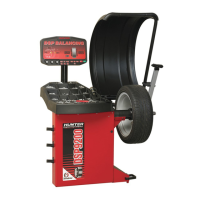Static and Dynamic Imbalance Sensitivity
As a general rule of thumb, to achieve the best balance on an average sized tire and
wheel assembly:
Residual static imbalance should be less than 1/2 ounce.
Residual dynamic imbalance should be less than 1/4 ounce per plane.
A small amount of residual dynamic imbalance is preferred over a similar amount of
remaining static imbalance.
In general, it takes much more residual dynamic imbalance to cause a vibration than
the same amount of static imbalance.
The larger the diameter used for weight placement, the smaller the amount of
correction weight is required.
The wider the distance between the two weight placement locations, the smaller the
amount of correction weight is required.
If static balance is the only option, always verify that the remaining dynamic residual
imbalance is within acceptable tolerance.
2.2 Identifying the Static Balance Weight Plane
In “STANDARD BALANCE” mode, using only a clip-on weight, the plane is input as
follows:
For static balancing, it is recommended that you place half of the correctional weight
value on each side of the tire to reduce residual dynamic imbalance.
In “MIXED WEIGHTS BALANCE” mode and “ADHESIVE WEIGHTS BALANCE”
mode, using an adhesive weight, the plane is input as follows:
DIAMETER
For static balancing, it is recommended that the adhesive weight be placed as close
to the center of the wheel as possible to reduce residual dynamic imbalance.
DSP9200 Series Balancer Operation Instructions 2. Balancing Overview
15

